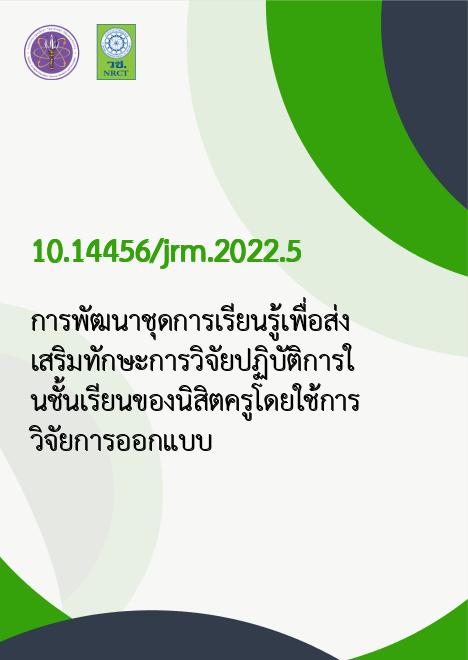
|
การพัฒนาชุดการเรียนรู้เพื่อส่งเสริมทักษะการวิจัยปฏิบัติการในชั้นเรียนของนิสิตครูโดยใช้การวิจัยการออกแบบ |
|---|---|
| รหัสดีโอไอ | |
| Creator | สุวิมล ว่องวาณิช |
| Title | การพัฒนาชุดการเรียนรู้เพื่อส่งเสริมทักษะการวิจัยปฏิบัติการในชั้นเรียนของนิสิตครูโดยใช้การวิจัยการออกแบบ |
| Contributor | ชยุตม์ ภิรมย์สมบัติ, กนิษฐ์ ศรีเคลือบ |
| Publisher | ภาควิชาวิจัยและจิตวิทยาการศึกษา คณะครุศาสตร์ จุฬาลงกรณ์มหาวิทยาลัย |
| Publication Year | 2565 |
| Journal Title | วารสารวิธีวิทยาการวิจัย (Journal of Research Methodology: JRM) |
| Journal Vol. | 35 |
| Journal No. | 1 |
| Page no. | 79-94 |
| Keyword | ชุดการเรียนรู้, ทักษะการวิจัยปฏิบัติการในชั้นเรียน, การวิจัยการออกแบบ, Learning Modules, Classroom Action Research Skills, Design Research |
| URL Website | http://research.edu.chula.ac.th/jrm/ |
| Website title | วารสารวิธีวิทยาการวิจัย (Journal of Research Methodology: JRM) |
| ISSN | ISSN 0857-2933; ISSN (Online) 2697-4835 |
| Abstract | การส่งเสริมทักษะการวิจัยปฏิบัติการในชั้นเรียนให้กับนิสิตครูนั้นควรเริ่มตั้งแต่การทำให้นิสิตครูเกิดความตระหนักต่อผลที่จะเกิดขึ้นกับการวิจัย และเกิดเจตคติที่ดีต่อการวิจัย เพราะคุณลักษณะทั้งสองนี้จะช่วยให้ผู้เรียนเกิดการรับรู้ความสามารถของตนเองด้านการวิจัยและเกิดความยึดมั่นผูกพันกับการวิจัย การวิจัยการออกแบบนี้จึงมีวัตถุประสงค์เพื่อออกแบบชุดการเรียนรู้เพื่อส่งเสริมทักษะการวิจัยปฏิบัติการในชั้นเรียนของนิสิตครูบนฐานของทฤษฎีและบริบทจริงโดยใช้วิธีวิจัยที่หลากหลายเข้ามาช่วย โดยระหว่างการวิจัยอาจจะมีการปรับทฤษฎีหรือกิจกรรมต่าง ๆ ที่ใช้ในการออกแบบให้เกิดความเหมาะสม โดยการวิจัยแบ่งออกเป็น 3 ระยะ ได้แก่ ระยะที่ 1 การพัฒนาหลักการออกแบบ (design principle) เพื่อเป็นฐานคิดในการกำหนดข้ออ้างเชิงเหตุผล (argument) ในการออกแบบชุดการเรียนรู้ โดยใช้การศึกษาเอกสาร แนวคิด ทฤษฎีที่เกี่ยวข้องร่วมกับการระดมความคิดจากผู้เชี่ยวชาญ ระยะที่ 2 การทดลองใช้ต้นแบบของชุดการเรียนรู้กับนิสิตครูที่มีบริบทต่างกันจำนวน 5 กลุ่ม ในการทดลองจำนวน 3 รอบ ทำการเก็บข้อมูลผ่านการสังเกตเป็นหลักควบคู่กับการทดสอบความรู้และการประเมินทักษะการวิจัยปฏิบัติการในชั้นเรียนผ่านชิ้นงาน จากนั้นวิเคราะห์ข้อมูลผ่านการวิเคราะห์เนื้อหา ระยะที่ 3 การนำเสนอหลักการออกแบบที่ปรับใหม่ (new design principle) โดยใช้การถอดบทเรียนจากการนำชุดการเรียนรู้ต้นแบบไปทดลองใช้ ผลการวิจัยพบว่า1. ชุดการเรียนรู้การวิจัยปฏิบัติการในชั้นเรียนต้นแบบประกอบด้วย 6 โมดูล ได้แก่ 1) บทนำสู่การวิจัยปฏิบัติการในชั้นเรียน 2) สภาพปัญหาและตัวแปร 3) การพัฒนาสู่ปัญหาวิจัย กรอบแนวคิด และการออกแบบการวิจัย 4) การนำ treatment สู่การปฏิบัติ และการเก็บข้อมูล 5) การวิเคราะห์ข้อมูล และการเขียนรายงาน และ 6) การอภิปรายผล การสะท้อนผล และการปรับ treatmentระยะเวลาที่ใช้ประมาณ 14 สัปดาห์ หลักการออกแบบชุดการเรียนรู้จะสร้างองค์ความรู้และทักษะการวิจัยปฏิบัติการในชั้นเรียนควบคู่กับการสร้างความตระหนัก เจตคติ การรับรู้ความสามารถในตนเอง และความยึดมั่นผูกพันกับการวิจัย2. ผลการทดลองใช้ชุดการเรียนรู้พบว่า นิสิตคิดว่าการทำวิจัยในชั้นเรียนไม่ใช่เรื่องยาก เห็นประโยชน์ ความสำคัญ ทำการค้นคว้าและการร่วมกิจกรรมต่าง ๆ อย่างต่อเนื่อง และมีความมั่นใจมากขึ้นในการออกแบบ และลงมือทำวิจัย ผลการทดสอบความรู้และการประเมินผลงานของนิสิตพบว่า นิสิตมีความรู้ที่ถูกต้อง รวมถึงผลงานของนิสิตมีความถูกต้องตามหลักการวิจัยปฏิบัติการในชั้นเรียน3. หลักการออกแบบใหม่ที่ถอดบทเรียนได้หลังจากการนำชุดการเรียนรู้ต้นแบบไปทดลองใช้คือ ชุดการเรียนรู้ต้องสร้างปฏิสัมพันธ์ระหว่างนิสิตกับกิจกรรมการวิจัยปฏิบัติการในชั้นเรียน และต้องมีความต่อเนื่องตั้งแต่ต้นจนจบกระบวนการ ต้องเน้นการสร้างความเชื่อมโยงหรือรอยต่อทางองค์ความรู้แต่ละเนื้อหาให้นิสิต อีกทั้งชุดการเรียนรู้ต้องมีสื่อหรือเอกสารต่าง ๆ จัดเตรียมไว้ให้ผู้ที่จะทำวิจัยเลือกใช้ และสามารถแลกเปลี่ยนสะท้อนข้อดี ข้อปรับปรุงของกิจกรรมต่าง ๆ ได้The enhancement of action research skills among student teachers should start with cultivating awareness of the effects of research among student teachers and a good attitude toward research. These two characteristics could help them recognize their research capability to develop a commitment to research. The current research endeavor aims to develop learning modules to enhance classroom action research skills of student teachers based on theories and the actual context of various research methods. There could be some adjustments to the ideas and activities adopted to be appropriate during the study process. The research study was divided into 3 phases. The first was the design principle, which served as the conceptual framework for developing the argument in the design of learning modules. This was implemented using experts' relevant documents, concepts, and theories. The second phase involved experimentation by using the prototype with five groups of student teachers in diverse contexts. There were three experiments whose data was principally collected through observations, tests, and classroom action research evaluations. After that, the data were analyzed by using content analysis. The third phase was the presentation of the new design principle using lesson transcription of the prototype. The research results revealed the following:First, the prototype consisted of 6 learning modules, including the introduction, problems and variables, research question, conceptual framework and design development, the realization of the treatment and data collection, data analysis and report writing, and results and discussions, reflections, and the treatment adjustment, which took 14 weeks to accomplish. The design principle will contribute to the development of classroom action research knowledge and skills, awareness, good attitudes, and recognition of their research capabilities leading to a commitment to research.Second, the prototype experiment unveiled that student teachers believed classroom action research was not complicated. Instead, they realized its importance, which stimulated them to dedicate themselves to study and other relevant activities constantly. They also became more confident in designing and implementing the research. The tests and evaluations found that student teachers had accurate knowledge, and their works followed the classroom action research principles.Third, the new design principle that was transcribed after the experiment of the prototype needed to create interactions between student teachers and the classroom action research activities and needed to be consistent throughout the entire process. It should emphasize the correlation in terms of knowledge for each content. Moreover, media or documents should be prepared for researchers, allowing for reflections and exchanging opinions and construction advice. |